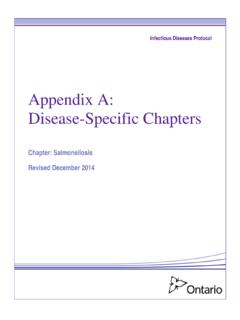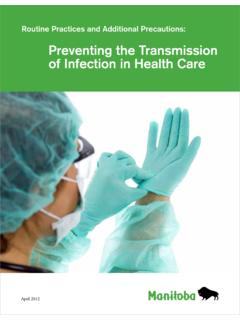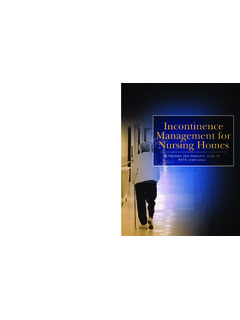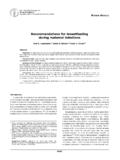Transcription of Global Strategy on Occupational Health for All - …
1 WH0 Strategy onOccupational Health for AllThe Way to Health at of the Second Meeting of theWHO Collaborating Centres in Occupational Health11-14 October 1994 Beijing, ChinaGENEVA 1995 Drawings on the cover pagesManu RantanenLayout of the cover pagesTuula Solasaari-PekkiISBN 95 l-802-07 1-X1995 This Document has been developed according to the guidance and contributions of thePlanning Group of the WHO Collaborating Centres Network, WHO Workers HealthProgramme and the Second Meeting of the WHO Collaborating Centres in OccupationalHealth. The Document was drafted for the WHO Collaborating Centres Network by theFinnish Institute of Occupational Health (drafted by Professor Jorma Rantanen witheditorial support from Ms. Suvi Lehtinen and technical assistance from Ms.)
2 RaijaSalmenius). It was printed in Finland with support from the Finnish Institute ofOccupational document is not a formal publication ofthe World Health Organization (WHO), andall rights are reserved by the document may, however, be freelyreviewed, abstracted, reproduced andtranslated, in pzirt or in whole, but not forsale nor for use in conjunction withcommercial document n est pas une publicationofficielle de l organisation mondiale de laSante (OMS) et tous les droits y afferentssont reserves par I Organisation. S il peutetre comment& resume, reproduit ou traduit,partiellement ou en totalite, il ne sauraitcependant 1 Etre pour la vente ou A des finscommerciales .The views expressed in documents bynamed authors are solely the responsibilityof those opinions exprimees dans les documentspar des auteurs cites nommement n engagentque lesdits summary 1 Introduction.
3 The right to Health at work5 The workplace and sustainable development 7 Situation analysis for Health at work and development of the globalworking life 9- Trends of Global economies 9- Demographic trends and working conditions of theglobal workforce 14- Situation and trends in Occupational Health and safety19 Exposures and hazards 19 Injuries, diseases and outcomes28 Emerging new problems 32A proposed Global Strategy on Occupational Health for All38- Basis for the Strategy 38- Principles of Occupational Health and safety41- Empowerment of the community 45- Objectives and actions 47 Global Strategy Objectives and Actions for Occupational Healthfor All 50 Partners for the implementation of the Global Strategy66 Follow-up of the implementation of the Global Strategy66 Abbreviations 68 PrefaceThe WHO policy has, since the foundation of the Organization, included elements foroccupational Health .
4 Numerous key documents of WHO, the Constitution, Alma AtaDeclaration, Health for All Strategy , the General Programmes of Work and severalresolutions of the World Health Assembly have emphasized the need to protect and pro-mote Health and safety at work by preventing and controlling of hazards in the work en-vironment and by promoting Health and the work capacity of working the numerous problems of Occupational Health and safety and looking at the newdevelopments and trends in the Global working life, the two Meetings of the Network ofWHO Collaborating Centres in Occupational Health , covering 52 research and expertinstitutions from 35 countries, have discussed the need for a new Global Strategy in Oc-cupational Health .
5 Such a Strategy should benchmark the priority actions for giving aneffective response to the new Occupational Health needs in the rapidly changing workinglife and also address to the great differences in the working conditions and occupationalhealth in countries at different stages of present document analyses the current situation and new needs of occupationalhealth in different parts of the world, and proposes policy principles, 10 objectives andinternational and national actions for further improvement of Occupational main emphasis is given to the preparation of new Occupational Health policies, de-velopment and strengthening of the necessary infrastructures, information systems andawareness of the needs and possibilities of Occupational Health activities, development ofoccupational Health services for all working people, and building up the necessary sup-port services and human resources needed for implementating the new Strategy .
6 Muchemphasis is given to collaboration within the WHO between the various InternationalOrganizations and Nongovernmental Organizations and between various disciplinesrelevant to Occupational Health . The necessity to develop collaboration and multidis-ciplinary approach, in Occupational Health practice at national and local levels is Second Meeting of the Network of Collaborating Centres in OccupationalHealth recommended that this Document be submitted for consideration by theWHO and it is proposed to be converted into the WHO Global Strategy on Occu-pational Health for All (The way to Health at work).It is the intention of the Network of the WHO Collaborating Centres in OccupationalHealth that this document stimulates discussions on needs and objectives for further de-velopment of Occupational Health and encourages policy and practical actions which arenecessary to meet the challenges of Occupational Health in the modern working Strategy1 onOccupational Health for AllExkutive summaryAbout 45% of the world s population and 58% of the population over 10 years ofage belong to the Global workforce.
7 Their work sustains the economic and mate-rial basis of society which is critically dependent on their working capacity. Thusoccupational health2 and the well-being of working people are crucial prerequi-sites for productivity and are of utmost importance for overall socioeconomic andsustainable is the objective of this Strategy that by the year 2000 the countries wheretrends in Occupational Health and safety are already positive, should demon-strate a further improvement of Occupational Health and safety indicators,showing a reduction of the difference between the level of Health and safety oflow-risk and high-risk occupations and enterprises. In countries where thepresent trends are still negative, positive development is expected and the le-gal and other actions, including the development of necessary resources andinfrastructures, should be taken to make such positive trends possible.
8 Allcountries should show a progressive development of Occupational healthservices with the ultimate objective of covering all workers with such servicesirrespective of the sector of economy, size of company, occupation, mode ofemployment, or nature of workplace is a hazardous environment. Occupational Health and safety2 haz-ards are common in many economic sectors and affect large numbers of 30-50% of workers report hazardous physical, chemical or bio-logical exposures or overload of unreasonably heavy physical work or ergonomicfactors that may be hazardous to Health and to working capacity; an equalnumber of working people report psychological overload at work resulting instress symptoms. Many individuals spend one-third of their adult life in suchhazardous work environments.
9 About 120 million Occupational accidents with200,000 fatalities are estimated to occur annually and some 68-157 million newcases of Occupational disease may be caused by various exposures at work. Inaddition to unnecessary human suffering, the costs involved in these Health haz-1ards have been estimated to amount up to several percent of some countries grossnational product (GNP).The most important challenges for Occupational Health by the year 2000 and be-yond will be: Occupational Health problems linked with new information tech-nologies and automation, new chemical substances and physical energies, healthhazards associated with new biotechnologies, transfer of hazardous technologies,aging of working populations, special problems of vulnerable and underservedgroups ( chronically ill and handicapped), including migrants and theunemployed, problems related to growing mobility of worker populations andoccurrence of new Occupational diseases of various some regions and countries, only 510% of workers in developing countriesand 20-50% of workers in industrialized countries (with a very few exceptions)have access to Occupational Health services in spite of an evident need virtually ateach place of work.
10 The need for Occupational Health services is particularlyacute in the developing and newly industrialized countries (NICs). Furthermore,approximately eight out of 10 of the worlds workers live in these countries. Suchservices, if organized appropriately and effectively for all workers, would con-tribute positively not only to workers Health , but also to overall socioeconomicdevelopment, productivity, environmental Health and well-being of countries,communities, families and dependents. Also the control of unnecessary costsfrom sickness absenteeism and work disability, as well as costs of Health care andsocial security can be effectively managed with the help of Occupational change of the modem working life is associated with increasing demandsof learning new skills, need to adapt to new types of work, pressure of higherproductivity and quality of work, time pressure and hectic jobs and with growingpsychological workload and stress among the workforce.


















